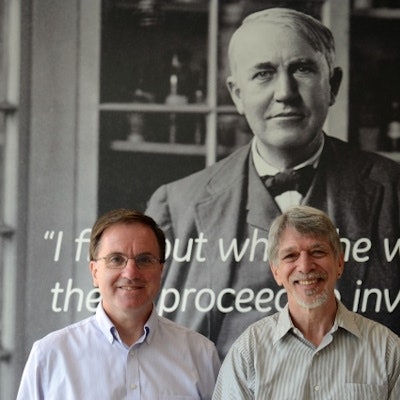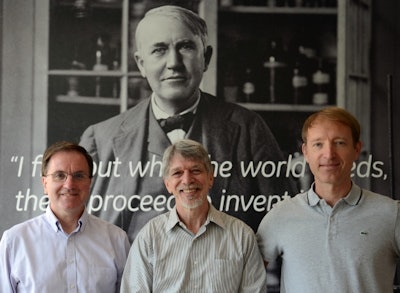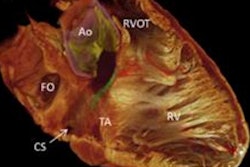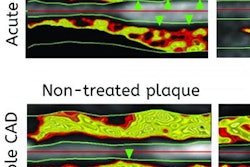
As the global population ages, the increasing volume of coronary CT angiography examinations being performed suggests a clinical need for a cost-effective dedicated cardiac CT scanner. Engineers at GE Global Research are leading an initiative to define and evaluate hypothetical solutions to meet this need. They have developed a method to determine architectures that could provide the best trade-off between performance and cost.
The R&D team, led jointly by GE's Bruno De Man and Ge Wang of Rensselaer Polytechnic Institute, conducted an extensive study underwritten by a grant from the U.S. National Institutes of Health (NIH) to evaluate various approaches to CT system design, including variations on conventional and unconventional architectures. Their main hope was to find an approach with the potential to outperform conventional architectures. The team described the comparative evaluation methods they used so that other researchers who wish to analyze the proposed CT architectures can utilize these as a reference framework.
 Peter M. Edic, principal engineer, Paul FitzGerald, experimentalist, and Bruno De Man, senior principal engineer and principal investigator, from the Imaging Technical Discipline at GE Global Research.
Peter M. Edic, principal engineer, Paul FitzGerald, experimentalist, and Bruno De Man, senior principal engineer and principal investigator, from the Imaging Technical Discipline at GE Global Research.The team hypothesized that a dedicated cardiac CT scanner would require a 300-mm field-of-view (FOV), 160-mm Z coverage, 50-mm temporal resolution, 20-lp/cm spatial resolution, and sufficient power to maintain image noise below 10 Hounsfield Units (HU). Images need to be acquired with the lowest radiation dose possible to produce diagnostic image quality without degrading artifacts. They evaluated six proposed CT architectures, including systems with one, two, and three beam lines (source-detector pairs) to address the challenge of temporal resolution (Medical Physics, 17 July 2017).
The researchers analyzed cost- and performance-related criteria for the comparative evaluation, each with specific detailed methods for scoring. These included the following:
- The inherent Radon completeness of the raw data with respect to being close to 100% to avoid conebeam artifacts.
- Integrated effective power -- the total capability to deliver x-ray energy to a patient within a given scan time, thus determining the lower limit of noise in raw data.
- The capability to provide required temporal resolution through high-speed data acquisition without including the effect of motion-correction algorithms.
- Dose efficiency -- the ability to deliver dose uniformly throughout the volume-of-interest and to measure the transmitted x-rays with minimal loss of information.
- The costs to develop new hardware technology, new software algorithms that would not have residual artifacts, and actual production costs.
As an example, the susceptibility to conebeam artifacts was analyzed to estimate the fundamental challenges associated with image reconstruction for each of the proposed CT architectures. To evaluate scatter, a critical concern in wide-cone CT architecture, the team first quantified the reduction in dose efficiency due to scatter and then evaluated forward scatter and cross-scatter for multiple sources irradiating a volume simultaneously. They also analyzed the effect of an antiscatter grid, utilization efficiency of the projection ray redundancy, virtual bowtie capability, and geometric irradiation efficiency.
The team then created a detailed prioritization matrix for system architectures for a single-, dual- and triple-source CT (SSCT, DSCT, and TSCT), as well as a dual twin-Z CT (DTZCT), a triple inverse-geometry CT (TIGCT), and a ring source, dual-rotating-detector CT (OSDRT). They describe the architectures and the performance of each proposed CT system in detail in their article.
The researchers determined the architectures that offered the best cost-performance were systems based on traditional x-ray tubes using one, two, or three beam lines. They eliminated the proposed TIGCT and OSDRT architectures with distributed sources due to cost and related performance characteristics. As modeled, the DTZCT architecture did not offer any significant improvements that could justify its increased cost.
Performance relative to the SSCT increased with the additional beam lines in DSCT and TSCT, but at additional cost.
"We found that CT system architectures based on the third-generation geometry provide nearly linear improvement versus the increased cost of additional beam lines, although similar performance improvement could be achieved with advanced motion-correction algorithms. The third-generation architectures outperform even the most promising of the proposed architectures that deviate substantially from the traditional CT system architectures," the authors wrote.
They concluded by saying their detailed evaluation confirms the validity of the current trend in commercial CT scanner design.
© IOP Publishing Limited. Republished with permission from medicalphysicsweb, a community website covering fundamental research and emerging technologies in medical imaging and radiation therapy.



















